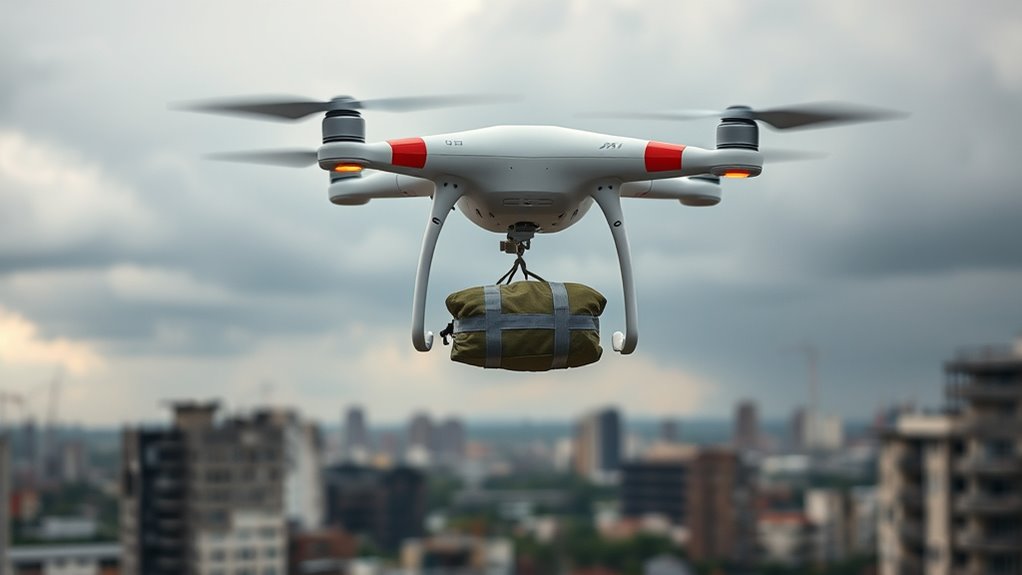Drone delivery of emergency supplies can substantially improve disaster response by quickly getting critical resources to hard-hit areas, bypassing traffic and difficult terrain. To guarantee safety, you must follow strict air traffic regulations, obtain necessary permits, and adhere to designated flight paths. Regular maintenance and inspections are also crucial to keep the drones reliable during urgent missions. Staying updated on regulations and protocols helps you deliver aid efficiently and safely—discover more about essential practices next.
Key Takeaways
- Drones enable rapid delivery of essential supplies to inaccessible or disaster-affected areas, saving lives.
- Compliance with air traffic regulations ensures safe, coordinated drone operations during emergencies.
- Regular maintenance and pre-flight checks enhance drone reliability and safety in critical delivery missions.
- Proper training and adherence to protocols minimize risks and improve response efficiency during crises.
- Integrating drone delivery into emergency response plans boosts overall effectiveness and saves time.

In times of crisis, getting emergency supplies quickly can save lives, and drone technology is transforming how aid reaches those in need. Drones can navigate challenging terrains, bypass traffic, and deliver vital resources directly to affected areas, making them invaluable during natural disasters or emergencies. However, to operate these devices safely and effectively, you need to understand the significance of adhering to air traffic regulations. These regulations are in place to prevent collisions, ensure safe flight paths, and coordinate with manned aircraft in shared airspace. When planning drone deliveries, you must obtain the necessary permits, follow designated flight corridors, and stay within prescribed altitude limits. Doing so not only keeps you compliant with legal requirements but also minimizes risks to other airspace users and the public.
Alongside adhering to air traffic regulations, maintaining your drones properly is essential. Drone maintenance protocols are designed to keep your equipment in peak condition, reducing the chances of failure during critical deliveries. Regular inspections of batteries, motors, propellers, and sensors are necessary. You should perform pre-flight checks to identify any signs of wear or damage, ensuring all components are functioning correctly before takeoff. Proper calibration of navigation systems and sensors is also indispensable, especially when flying in complex environments or low visibility conditions. Keeping detailed maintenance logs helps track the drone’s performance and facilitates troubleshooting if issues arise. When you follow these protocols diligently, you increase the reliability and safety of each emergency delivery, which can be the difference between life and death in crucial moments.
Furthermore, integrating these protocols into your operations involves continuous training and staying updated on evolving regulations. Air traffic regulations can change as authorities adapt to new technology and airspace management strategies. Staying informed about these updates ensures your drone operations remain compliant and safe. Similarly, adhering to drone maintenance protocols means you’re prepared for unforeseen challenges, reducing downtime and avoiding costly repairs. It’s a proactive approach that safeguards your equipment, your team, and the recipients of your aid. By combining strict compliance with air traffic regulations and rigorous drone maintenance, you ensure your deliveries are timely, efficient, and safe. This level of professionalism not only enhances the credibility of your operations but also maximizes the positive impact you can make during emergencies. In the end, your meticulous attention to these details can save lives, proving that responsible drone use is essential in delivering critical supplies when they’re needed most.
Additionally, understanding the Gold IRA investment process can help fund emergency initiatives or sustain ongoing aid efforts in the long term.
Frequently Asked Questions
How Are Drone Delivery Routes Optimized in Disaster Zones?
You optimize drone delivery routes in disaster zones by using autonomous navigation systems that adapt to changing conditions. You program drones with obstacle avoidance technology, allowing them to navigate around debris and hazards safely. You also analyze real-time data to identify the fastest, safest routes. This combination guarantees your drones deliver supplies efficiently, even in unpredictable environments, helping save lives and reduce response times during emergencies.
What Are the Costs Associated With Implementing Drone Delivery Systems?
You’ll find that implementing drone delivery systems involves significant costs, including equipment, maintenance, and training. Conducting a thorough cost analysis helps you understand these expenses and plan accordingly. Funding sources vary, from government grants to private investments, which can offset initial costs. While the upfront investment is substantial, the efficiency and speed benefits in disaster zones often justify the expenditure, ultimately saving lives and resources.
How Do Drones Handle Adverse Weather Conditions During Deliveries?
During adverse weather conditions, drones rely on weather resilience and advanced drone stabilization to guarantee safe deliveries. You’ll find that modern drones are equipped with sensors and algorithms that adapt to wind, rain, and turbulence, maintaining stability and precise navigation. This technology helps you deliver emergency supplies reliably, even in challenging weather. While extreme conditions can still pose risks, ongoing improvements are making drone operations more resilient and dependable in all weather scenarios.
What Measures Ensure the Security of Emergency Supplies During Transit?
Think of your supplies as delicate glassware in a storm; you need sturdy protection. You guarantee cargo safeguarding by using tamper-proof containers and secure locking mechanisms. Encryption protocols act as an unbreakable shield, safeguarding data during transit. These measures prevent theft, tampering, and loss, making sure your emergency supplies arrive intact and ready to save lives. Your proactive security keeps chaos at bay and trust firmly in your delivery system.
How Is Air Traffic Managed With Increased Drone Delivery Operations?
You’re involved in managing air traffic by adhering to strict airspace regulation, which helps prevent drone traffic congestion. Authorities assign designated flight zones and set altitude limits, ensuring drones operate safely alongside manned aircraft. Advanced traffic management systems monitor drone routes in real time, allowing you to coordinate and adjust flights efficiently. This organized approach preserves airspace safety, reduces congestion, and ensures timely delivery of emergency supplies without compromising safety.
Conclusion
While some might worry about drone safety or privacy, embracing drone delivery for emergencies saves lives and reduces response times. You don’t need to guarantee these innovations; instead, see them as tools that enhance safety and compassion in crises. When every second counts, using technology to deliver urgent supplies ensures help reaches those who need it most, quickly and efficiently. Embracing this progress means you’re supporting faster救援 and saving more lives.










